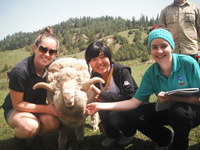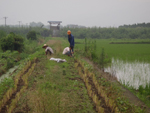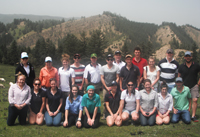Modern Chinese agriculture and ancient traditions
Author: Emily Malone
Publication Date: Wednesday, 25 Sep 2013
A mix of modern farming techniques and ancient traditions is how Charles Sturt University (CSU) student Ms Kate Molloy sums up a recent tour of agricultural industries in China.
 A Bachelor of Agricultural Science student at CSU in Wagga Wagga, Ms Molloy was one of 21 undergraduate students from CSU's School of Agricultural and Wine Sciences who spent two weeks in China in June and July.
A Bachelor of Agricultural Science student at CSU in Wagga Wagga, Ms Molloy was one of 21 undergraduate students from CSU's School of Agricultural and Wine Sciences who spent two weeks in China in June and July."We discovered a country with an expanding agricultural industry that is incorporating modern methods to better their cultivation while keeping in mind their traditions and ancient methods," said Ms Molloy.
The group visited a variety of farming operations from tropical rice and horticulture in the Yangtze River Delta in eastern China, to nomadic grazing systems in Inner Mongolia.
Agriculture advancing in China
"The agricultural techniques were much more advanced than I expected and the people we met expressed a desire to increase the agricultural relationship between our two countries," said Ms Molloy.

She was struck by contrasts in the type of farming operations and the wealth of farmers in different parts of China.
"In the Zhejiang province the land had been sold to the government and therefore the farmers were richer but did not own the land they cultivated. In the Gansu province farmers were less wealthy as they owned the land and wore the costs of cultivation."
"At a tea plantation in Hangzhou ancient methods were still utilised, for example only women are allowed to harvest the delicate leaves so they weren't tarnished or broken by impatient men," said Ms Molloy. "The leaves were dried by men tossing them in electric bowls that could get up to temperatures of 200 degrees Celsius."
"We visited a provincial government farm on the way to Zhangye where the main research goals were breeding better quality rams for use by local farmers and to produce semen for artificial insemination all over the country.
"They also bred sheep for traits suited to the climate using a variety of breeds such as Dorset and Suffolk sheep from New Zealand, Dorper sheep from Africa and Texel sheep from Australia."
Comparing lives and cultures
Another highlight was visiting Gansu Agricultural University and meeting some of the students.
"It was a great cultural experience as we discussed their aspirations and university experience," she said. "We discovered a lot of similarities in our modern cultures and were able to relate quite well."
Aside from gaining an insight into agriculture, the students took in the sights and immersed themselves in the local culture.
 "When visiting a grazing village in Inner Mongolia the local women welcomed us with song and we ate a meal of goat and camel meat inside a traditional Mongolian style tent, or yurt, which was like a small dome," said Ms Molloy.
"When visiting a grazing village in Inner Mongolia the local women welcomed us with song and we ate a meal of goat and camel meat inside a traditional Mongolian style tent, or yurt, which was like a small dome," said Ms Molloy."This was the journey of a lifetime that I was able to share with other like-minded students interested in learning about Australia's international agricultural connections.
"The culture shock was massive but I am certain that every student on this trip gained an appreciation and understanding of China's differences in both society and agriculture."
ends
Media contact: Emily Malone, (02) 6933 2207
Media Note:
The tour to China was partially funded by the Australian Government’s Study Overseas Short-term Mobility Program through the Department of Innovation Science, Research and Tertiary Education. It was supported by CSU Global, a University initiative to encourage international study experiences. This included a Vice-Chancellor Travel Grant for students. Photos thanks to Ms Kate Molloy and Dr Shevahn Telfser.
